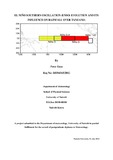| dc.contributor.author | Enos, Peter | |
| dc.date.accessioned | 2013-10-25T13:40:40Z | |
| dc.date.available | 2013-10-25T13:40:40Z | |
| dc.date.issued | 2013 | |
| dc.identifier.citation | postgraduate diploma in Meteorology, University of Nairobi, 2013. | en |
| dc.identifier.uri | http://erepository.uonbi.ac.ke:8080/xmlui/handle/123456789/57927 | |
| dc.description.abstract | The relationship between seasonal rainfall and various Niño indices is investigated in this study. Rainfall used covered eighteen gauge stations distributed throughout Tanzania. The data for both rainfall and ENSO evolution phases were monthly in nature covering the periods 1982 to 2012. Seasonal rainfall totals for both March-April-May and October-November-December are calculated from the raw rainfall data and then standardised to remove the mean. The same is done for the Niño indices. Simple linear correlation and regression techniques are then applied to the data to get the linear relationships inherent in the data. It is found that most of the stations during the season of March to May are not affected by El-Nino evolution phases as most of them registered a p-value higher that 0.05 which is the significant level set for this study. This was mainly during a one season lag (January to February). During lag 0, stronger correlations are observed which also failed to reach a cut-off point of less than 0.05 in terms of the p-value. However, October to December season performed better than the season of March to May with some stations registering highs of 0.5 in terms of the correlation coefficients. Nevertheless, most of the correlations were still poor and could not allow for regression model building. Bukoba rainfall station was the only synoptic rainfall station that could have allowed for model construction during the season of March-April-May while Kigoma and Arusha permitted model construction during the season of October to December season. It was found that Niño 3.4 was the only index that accounted for more than 10% of rainfall variability in the 3 stations mentioned above. It is concluded that if the relationship between ENSO and rainfall over Tanzania is linear in nature then, there is no connection between seasonal rainfall and ENSO over Tanzania. | en |
| dc.language.iso | en | en |
| dc.publisher | University of Nairobi | en |
| dc.title | El Niño Southern Oscillation (enso) Evolution And Its Influence On Rainfall Over Tanzania | en |
| dc.type | Thesis | en |
| local.publisher | Department of Meteorology | en |

